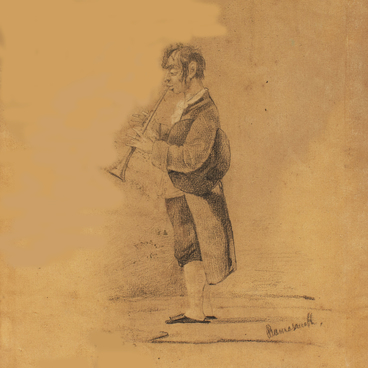In the collection of the Tarusa Art Gallery there are works of decorative and applied art. Among them are faience and porcelain dishes of the 19th century. One of these exhibits is a small plate with the image of a walking boy, made at the Kiev-Mezhyhirska faience factory in the second half of the 19th century.
The Kiev-Mezhyhirsky Imperial Faience Factory is the first porcelain and faience factory in the Russian Empire, which existed from 1798 to 1874 with its center in the village of Mezhyhirya. It was founded by the decree of Paul I after the discovery of a deposit of white clay called ‘kaolin’ on the territory of the burnt Mezhygorsk Savior-Transfiguration Monastery.
Basically, the factory made faience art ware covered with blue, white, green, yellow, lilac glaze, and used grapevine and dodder as ornaments for reliefs. Vases and sculptures were also made. Initially, samples of English faience were used as examples. Later the models from the Imperial Porcelain Factory in St. Petersburg began to be embodied. In the 1840s, samples with subject paintings and portraits were introduced into production. Nevertheless, despite the demand for products, the factory did not survive the economic crisis and was closed.
The most productive years of the factory were the 1850s. Probably, a plate from the gallery’s collection belongs to this period. The plate is decorated with brush color painting, based on samples from St. Petersburg, and is part of the table service. It’s made in the so-called Chinese style. The side of the object is decorated with a relief floral ornament. It frames the painting in the form of non-repeating floral motifs. In the center there is an image of a boy walking from the back, his face is turned into a profile. The composition is made on a white background with rich colors: red, blue, green, brown and pink. The character’s outfit matches the large, detailed colors in the background.
The Kiev-Mezhyhirsky Imperial Faience Factory is the first porcelain and faience factory in the Russian Empire, which existed from 1798 to 1874 with its center in the village of Mezhyhirya. It was founded by the decree of Paul I after the discovery of a deposit of white clay called ‘kaolin’ on the territory of the burnt Mezhygorsk Savior-Transfiguration Monastery.
Basically, the factory made faience art ware covered with blue, white, green, yellow, lilac glaze, and used grapevine and dodder as ornaments for reliefs. Vases and sculptures were also made. Initially, samples of English faience were used as examples. Later the models from the Imperial Porcelain Factory in St. Petersburg began to be embodied. In the 1840s, samples with subject paintings and portraits were introduced into production. Nevertheless, despite the demand for products, the factory did not survive the economic crisis and was closed.
The most productive years of the factory were the 1850s. Probably, a plate from the gallery’s collection belongs to this period. The plate is decorated with brush color painting, based on samples from St. Petersburg, and is part of the table service. It’s made in the so-called Chinese style. The side of the object is decorated with a relief floral ornament. It frames the painting in the form of non-repeating floral motifs. In the center there is an image of a boy walking from the back, his face is turned into a profile. The composition is made on a white background with rich colors: red, blue, green, brown and pink. The character’s outfit matches the large, detailed colors in the background.



